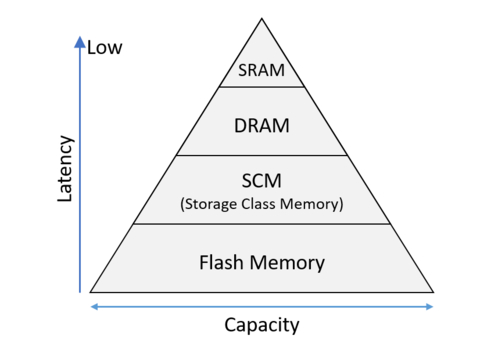Kioxia to Unveil Emerging Memory Technologies at IEDM 2024

Kioxia Corporation, a world leader in memory solutions, today announced that the company’s research papers have been accepted for presentation at IEEE International Electron Devices Meeting (IEDM) 2024, a prestigious international conference to be held in San Francisco, USA, from December 7th to 11th.
This press release features multimedia. View the full release here: https://www.businesswire.com/news/home/20241021336053/en/
Memory Hierarchy (Graphic: Business Wire)
Kioxia is committed to the research and development of semiconductor memory, which is indispensable for the advancement of AI and the digital transformation of society. Beyond its state-of-the-art three-dimensional (3D) flash memory technology BiCS FLASH™, Kioxia excels at research in emerging memory solutions. The company is constantly striving to meet the needs for future computing and storage systems with innovative memory products.
Existing computing systems leverage DRAM, a primary memory device enabling CPU to process data swiftly, alongside flash memory for the storage of extensive data. Kioxia is spearheading research and development for Storage Class Memory (SCM), a memory solution positioned between DRAM and flash memory in the semiconductor memory hierarchy, designed to handle larger data volumes than DRAM and at higher speed than flash memory.
At IEDM, Kioxia will unveil cutting edge technologies tailored to each of these three semiconductor memory layers: (1) a new type of DRAM utilizing oxide semiconductors with a focus on reducing power consumption, (2) MRAM suitable for larger capacities for SCM application, and (3) a novel structure of 3D flash memory with superior bit density and performance.
Emerging Memory Technologies:
1. Oxide-Semiconductor Channel Transistor DRAM (OCTRAM): This technology was jointly developed by Nanya Technology and Kioxia Corporation. The companies developed a vertical transistor that enhances circuit integration by improving the manufacturing process. The companies achieved extremely low current leakage by bringing out the properties of the transistor using an oxide-semiconductor. This can potentially lower power consumption in a wide range of applications, including AI and post-5G communication systems, and IoT products.
Paper Title: Oxide-semiconductor Channel Transistor DRAM (OCTRAM) with 4F2 Architecture (Paper Number: 6-1)
2. High-Capacity Crosspoint MRAM Technology: This technology was jointly developed by SK hynix Inc. and Kioxia Corporation. With this technology, the companies achieved cell read/write operation at the smallest-ever scale of cell half-pitch of 20.5 nanometers for MRAM by combining cell technology that pairs selectors suitable for large capacities with magnetic tunnel junctions, and applied fine processing technology for crosspoint-type arrays. Memory reliability tends to degrade as cells are miniaturized. The companies developed a potential solution by utilizing a new readout method that leverages the transient response of selectors and by reducing the parasitic capacitance of readout circuits. This technology has practical applications for AI and big data processing.
Paper Title: Reliable memory operation with low read disturb rate in the world smallest 1Selector-1MTJ cell for 64 Gb cross-point MRAM (Paper Number: 20-1)
3. Next-Generation 3D Memory Technology with Horizontal Cell Stacking Structure: Kioxia developed a new 3D structure to improve reliability and prevent degradation of NAND-type cell performance. Degradation of performance typically occurs when the number of stacked layers increases in conventional structures. The new structure arranges NAND-type cells horizontally by stacking them compared to the conventional structure of vertically arranging NAND-type cells. This structure allows for the realization of 3D flash memory with high bit density and reliability at low cost.
Paper Title: Superior Scalability of Advanced Horizontal Channel Flash For Future Generations of 3D Flash Memory (Paper Number: 30-1)
For more details on IEDM, please visit: https://www.ieee-iedm.org/
Under its mission of “uplifting the world with ‘memory’”, Kioxia aims to pioneer a new era with memory technology and will continue to promote research and technological development to support the future of digital society.
###
This announcement has been prepared to provide information on our business and does not constitute or form part of an offer or invitation to sell or a solicitation of an offer to buy or subscribe for or otherwise acquire any securities in any jurisdiction or an inducement to engage in investment activity nor shall it form the basis of or be relied on in connection with any contract thereof.
Information in this document, including product prices and specifications, content of services and contact information, is correct on the date of the announcement but is subject to change without prior notice.
About Kioxia
Kioxia is a world leader in memory solutions, dedicated to the development, production and sale of flash memory and solid-state drives (SSDs). In April 2017, its predecessor Toshiba Memory was spun off from Toshiba Corporation, the company that invented NAND flash memory in 1987. Kioxia is committed to uplifting the world with memory by offering products, services and systems that create choice for customers and memory-based value for society. Kioxia’s innovative 3D flash memory technology, BiCS FLASH™, is shaping the future of storage in high-density applications, including advanced smartphones, PCs, SSDs, automotive and data centers.
View source version on businesswire.com: https://www.businesswire.com/news/home/20241021336053/en/
![]()

